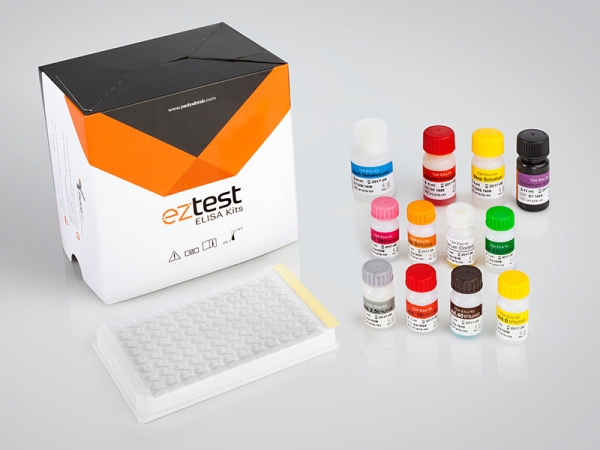| Name | Ferritin ELISA Test kit |
| Full name | Human Ferritin ELISA Test kit |
| Category Name | Anemia ELISA kits |
| Test | 96 |
| Method | ELISA method: Enzyme Linked Immunosorbent Assay |
| Principle | ELISA principle - Peroxidase conjugated |
| Detection Range | 0-1000 ng/mL |
| Sample | 20µl serum |
| Sensitivity | 2 ng/mL |
| Total Time | ~60 min |
| Shelf Life | 12 Months from the manufacturing date |
Ferritin ELISA kit description:
This Ferritin ELISA test kit is a Quantitative test based on a solid phase enzyme-linked immunosorbent assay that screens for Iron-deficiency anemia.
Materials provided with Ferritin ELISA Test Kit:
1. Anti-Ferritin Antibody-coated ELISA Microplate (96 wells)
2. enzyme conjugate reagent: 2 Vials contains anti-Ferrtin-HRP with preservative buffer, ready to use.(2 vials, 12 ml)
3. Ferritin test reference standard set, contains 0, 10, 100, 250, 500, & 1000 ng/ml(human liver standard 602/80 WHO IRP) ready for use
4. TMB Substrate: Hydrogen peroxide and tetra-methyl benzidine in preservative buffer, ready to use. (1 vial of 11ml)
5. Stop Solution: a normal hydrochloric acid (1 vial, 6 ml).
6. Concentrated washing buffer: PBS-Tween (1 vial 30ml) (20X)
7. Control serum: ferritin in serum with preservatives(1Vial, 0.5 ml)
Materials Required,but not Provided:
1. Precision pipettes(20,50,100,200 µl)
2. Distilled or deionized water
3. EIA kit Microplate Washer
4. EIA kit Microplate Reader with a 450 nm, If possible, 630 nm as reference.
5. Absorbent paper
Introduction
Ferritin molecule consists of 24 peptide subunits with molecular weight of 20,000 for each subunit. Ferritin serves to store iron in body tissues in a non-toxic form, to deposit it in a safe form for the cells. Ferritin is available in liver, spleen and bone marrow with a high concentration. In the shell of each Ferritin molecule there are about 3000 to 4500 of iron atoms (Fe3+) that contains approximately 20% of whole body iron. There is a little Ferritin in the serum with direct relationship with the stored Ferritin in body tissues; so, measurement of the available Ferritin in the serum is used to determination of whole body iron store. Ferritin serum concentration level is related to body iron stores and is influenced by several changes in the amount of the iron due to age and gender. The influence of factors has a significant impact on iron balance. Measurement of the serum Ferritin is important for high and low concentration of the iron diagnosis and diagnosis of iron deficiency anemia with other anemia. Newborns have high cord serum ferritin levels that decrease in childhood period but a progressive increase in male adults causing the excess of iron storage in the body and increase of the Ferritin. Ferritin level decreases in pregnant women until the menopause period but then Ferritin level of the serum increases in females. High serum Ferritin levels associate with Hereditary hemochromatosis and iron overload. Ferritin moderate increase can be seen in acute inflammations caused by infection, injury or tumor and liver diseases.
Principle of the assay
Ferritin Human ELISA kit is designed based on immunoenzymometric assay. This assay is based on specific monoclonal antibody by the use of sandwich method. Anti-Ferritin monoclonal antibody is used to conjugation with HRP enzyme for coating between the solid phase and an Anti-Ferritin antibody. By addition of the sample serum, the Ferritin molecule reacts with mentioned antibodies and sandwiches between bounded antibody on the solid phase and conjugated antibody. After an incubation period (45 minutes at room temperature), the sample is then decanted and the wells are washed to remove unbound-labeled antibody. An enzyme substrate-chromogen is added to the well and incubated for 15 minutes at room temperature, resulting in the development of a blue color. The addition of stop solution will stop the reaction and converts the color to yellow. The intensity is measured at 450 nm. The intensity of the yellow color is directly proportional to the concentration of Ferritin in the sample.



